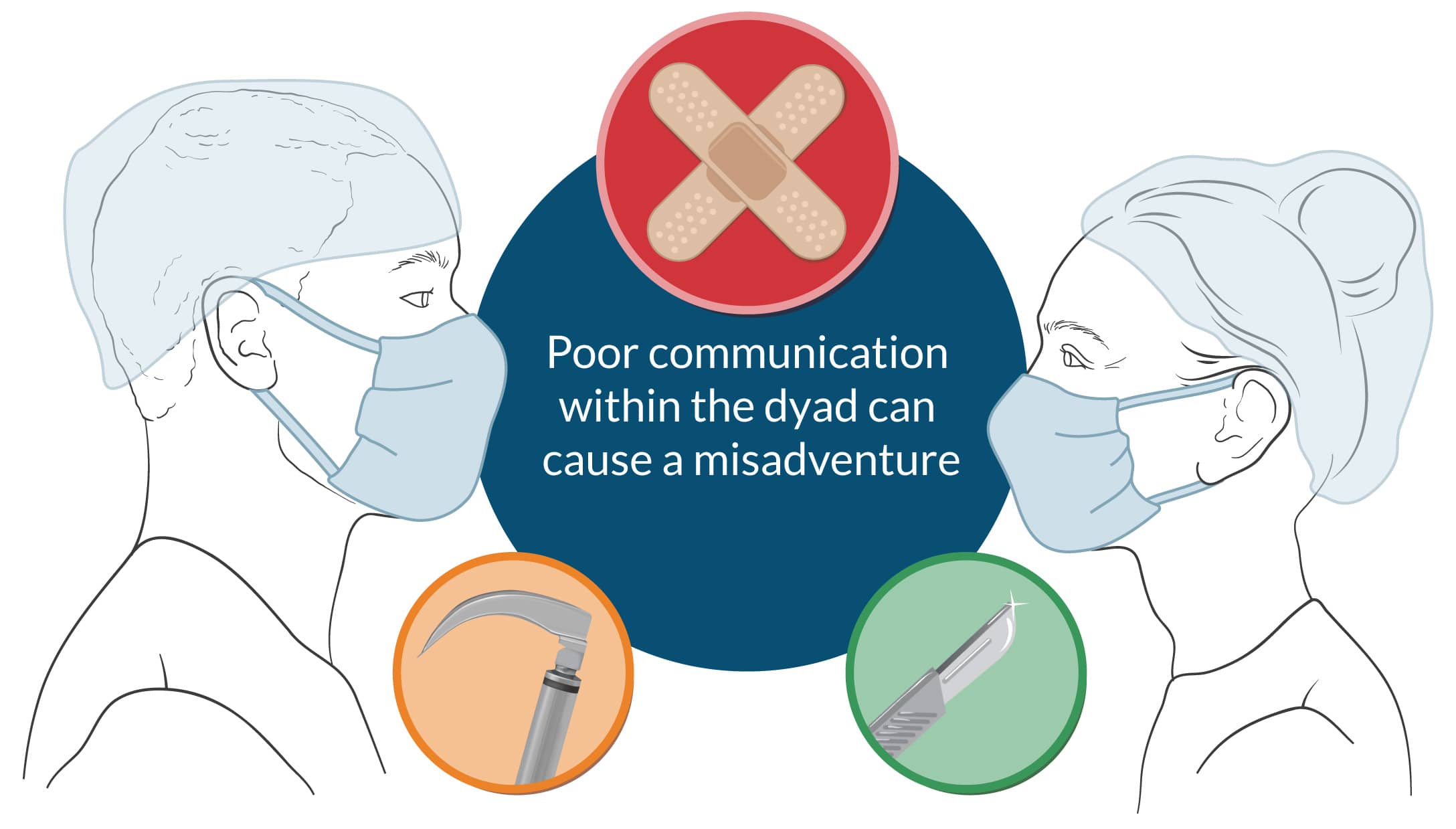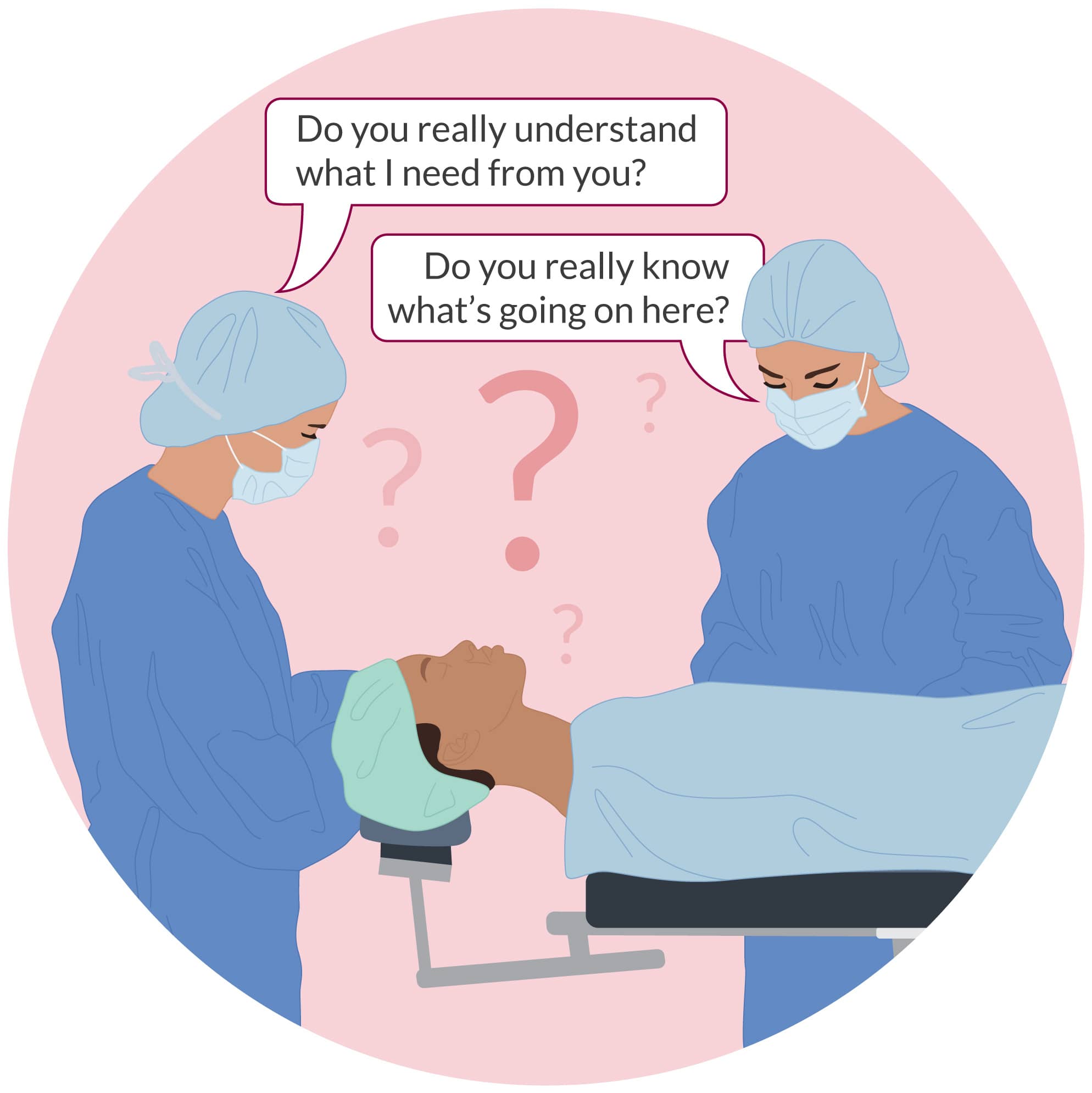‘Surgery!’ Can you tell me if things are OK down there?
You’ve likely never addressed your surgeon as ‘Surgery!’ and perhaps you’ve not been addressed by a surgeon as “Anesthesia!” instead of the name your parents gave you. However, this moniker may ring true for many of our readers. “Anesthesia! Can you give me more Trendelenburg,” or “Anesthesia! How about loosening up these muscles” are not queries; rather, they are implicit directives we’ve encountered. The interprofessional relationship between the surgeon and their anesthesia provider is often very superficial and impersonal, especially regarding 2-way communication and collaborative care.
There are many reasons for this, and we will only mention a few. In busy centers, CRNA staffing may easily exceed two or three dozen, often far more, with rooms and cases arbitrarily assigned. Even in community settings, case assignments among surgeons and anesthesia providers may fail to optimize the surgeon-anesthetist relationship resulting in little rapport between the dyad.
Surgical and anesthesia staff turnover can lead to a merry-go-round of new faces. There is also the simple failure to properly introduce oneself beyond the now mandated but too often perfunctory “time-out.”
Yet, a wealth of studies, reports, and closed claims analyses show that a failure to communicate is often the foundation of a patient’s misadventure. In some scenarios, misadventures may result in morbid or mortal events. Let’s look at some cases found in Closed Claims Analyses where we have protected the identities of the patients and their providers.
Table of Contents
- When communication goes awry
- Critical team members under the microscope
- A case report of failed communications
- The CRNA – surgeon interpersonal dyad
- Where we go from here
When communication goes awry
Case #1. This case involved disagreement and disrespect in treating an intraoperative complication. A 55-year-old male patient underwent an emergency laparotomy for ischemic and perforated bowel. The SpO2 decreased significantly with high ventilation pressures as the surgeon began closure. The anesthetist requested the surgeon to stop closing and seek the cause for what was being observed. The surgeon took offense to the suggestion and continued closing. The SpO2 hovered in the mid-80s. At the case end, within minutes after transfer to the ICU, the patient arrested. ACLS and stat laparotomy to relieve abdominal compartment syndrome improved hemodynamics and saturation. The patient sustained a hypoxic CNS injury.
Case #2. This case involved unnecessary production pressure. A difficult IV placement in the preop area delayed the case. The surgeon threatened to cancel the case if not in the room in 10 minutes, an admonition heard by the patient. The anesthetist asked to speak to the surgeon away from the patient, which did little to defuse the tension. A central line was attempted with the anesthetist visibly anxious and feeling rushed. A pneumothorax resulted. In legal proceedings, the patient testified to the verbal conflict between the providers.

When miscommunication occurs in patient care or even the appearance of it, it shines a spotlight on how impactful interprofessional relationships are.
Critical team members under the microscope
The experience and familiarity of teams have long been studied and revealed to be associated with success in domains as diverse as sports, aviation, the armed forces, and even child daycare settings. The cohesiveness and familiarity can result in a gestalt that evolves, involving shared information, mental models, mutual respect, and trust. A cultural foundation emerges that improves performance even when an unexpected scenario occurs.
Studies reveal that procedures performed by an experienced, high-volume surgeon are associated with better outcomes than those by a lower-volume surgeon. But what evidence exists for the anesthesia provider? A recent study revealed that higher volume for the anesthesia provider in challenging GI procedures was associated with a decrease in major patient morbidity. Let’s think of the surgeon and the anesthetist as representing a high-level, functioning “dyad.” Formal dyads are used in some institutions (e.g., solid organ transplants, complex pediatric procedures, complicated OB cases, etc.), but this represents a small subset of cases.
Another case of bad outcome with several dyad issues
A 27-year-old was to undergo a right Achilles tendon repair under GA as indicated on the OR schedule and the consent form. Although “sign your site” was routine, it’s unclear if it was performed in this case. During the ‘time out,’ the surgeon was on the phone and participating in a highly distracted manner. This ‘troubled’ the anesthetist, but she remained quiet given previous unpleasant interactions with the surgeon. An incision was made on the left ankle……….
Reflecting on the presented cases, our own practice experiences, and the complexities of interpersonal relationships, we identified many communication threats that are operative daily. Complexities abound—complex patients, procedures, drugs, and equipment. The “human condition” also defines and may affect our psychology and emotions. And let’s throw in the potential for complex patient unpredictability.
The surgeon-anesthetist dyad under the microscope
And then we have the surgeon-anesthetist dyad to consider and a fascinating, 2023 paper in JAMA Surgery. Here, the researchers examined the dyad’s familiarity with working with one another and its influence on 90-day morbidity in patients undergoing complex GI surgery. Included were 7893 adults posted for esophagectomy, pancreatectomy, or hepatectomy for GI cancer at a center known for this care.

As a preamble to their unique study, the authors emphasized that “high-reliability” organizations—such as the military, aviation, automotive manufacturing, etc.—have at their foundation, a dependency on team functioning. The environment the CRNA works in is an excellent example of a “high-reliability” organization.
We work in a high-stakes, collaborative, and demanding environment where teamwork is vital. Despite the insular nature of the CRNA’s practice—we get little real-time feedback from anyone except the patient—what does familiarity with other team members, especially the surgeon, bring to the provided care? It appears familiarity may play a substantial role.
In the JAMA Surgery paper, the researchers measured how many similar procedures a particular anesthetist performed with a particular surgeon. Remarkably, each additional procedure performed by the same surgeon-anesthetist dyad was associated with a 5% decreased risk of a 90-day major adverse event experienced by the patient. At face value, this is a remarkable finding.
The study was simple, straightforward, and pragmatic, without complex statistical transformations. Yet, the study provides novel and compelling information about the potential benefits of cultivating familiarity in this dyad. You might be thinking, is this plausible?
Given that this was an observational study, not a randomized trial, we can only speculate about the association of dyad familiarity and patient outcome. But let’s consider a few speculations of what might be operative here.
- We know from studies in other fields that building team members’ familiarity and stability can build trust and respect.
- There is ample evidence that communication in patient care and collaborative fractures are a common cause of errors and misadventures.
- Shared appreciation and understanding of what each dyad member is experiencing may engender self-disclosure, trust, and a desire to support one another.
- Trust and openness with one another may promote effective and seamless delivery of coordinated care.
- Expanding trust and respect may enhance the quality of the dialogue during patient care, extinguishing artificial boundaries that might be created due to ego or a sense of “this is my turf.”
Where do we go from here?
For many reasons, there is an unprecedented demand for anesthesia providers. Salaries, employment opportunities, and recognition for what CRNAs provide to an institution are arguably high. Yet, so are the profession’s demands, such that job satisfaction, burnout, and wellness can erode.
The JAMA Surgery paper gives us food for thought. From a practical perspective, we appreciate that institutions will not likely create specific dyads to deliver care in all cases. That said, we are optimistic that openly discussing it creates avenues for thinking about how fostering familiarity, respect, trust, and a better understanding of the dyad’s nuanced goals may optimize patient outcomes.
As CRNAs ourselves, we understand the challenge of fitting CRNA continuing education credits into your busy schedule. When you’re ready, we’re here to help.







